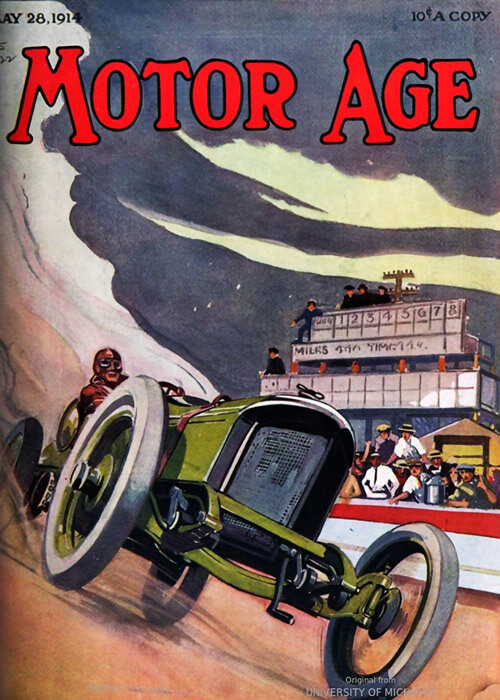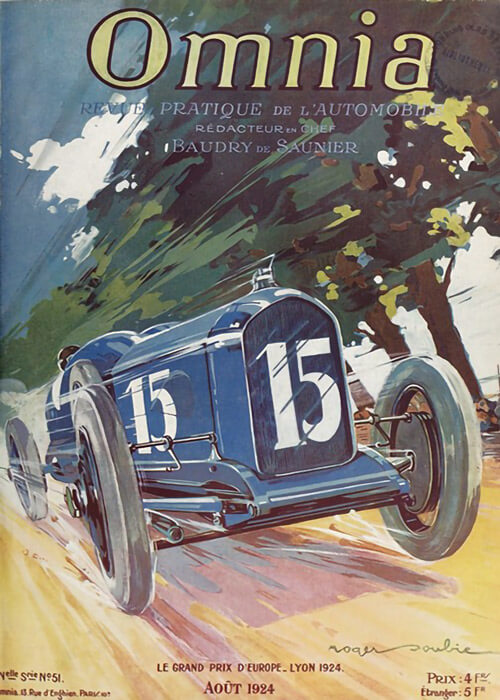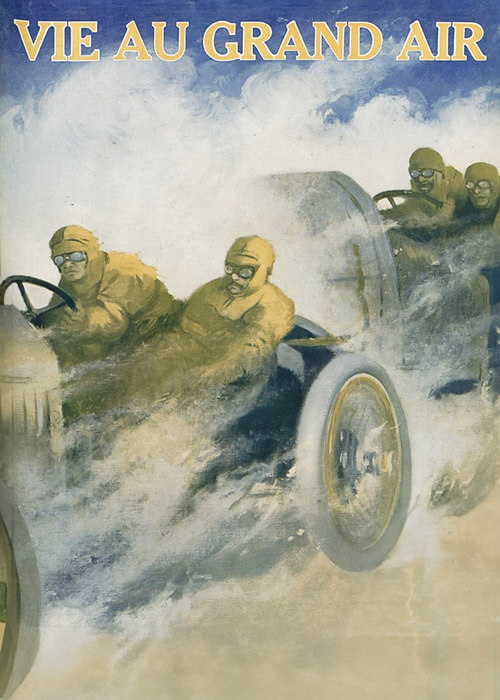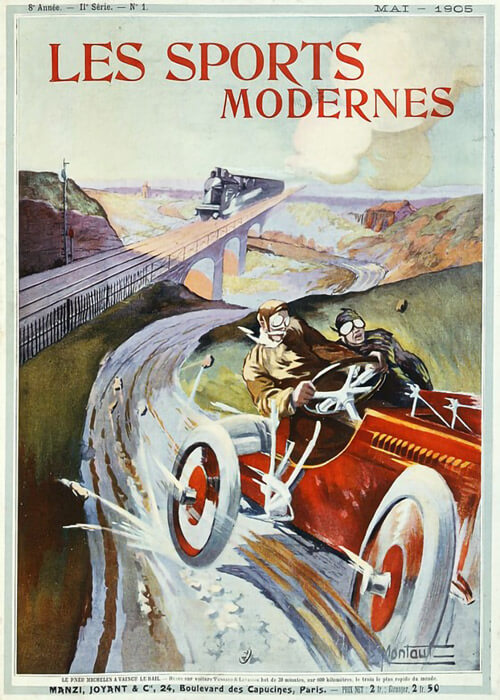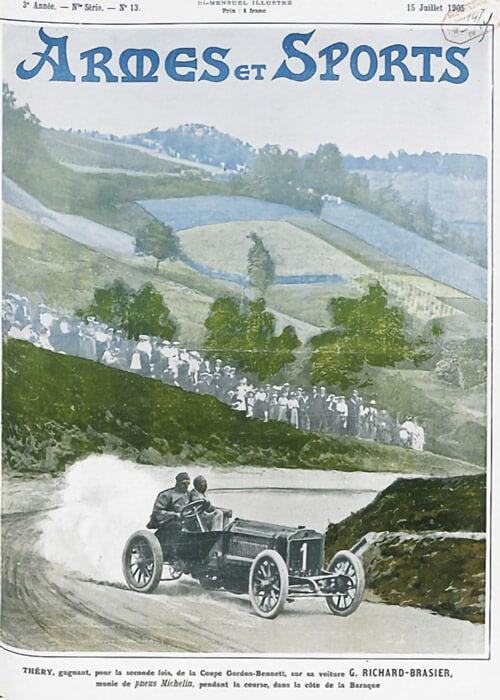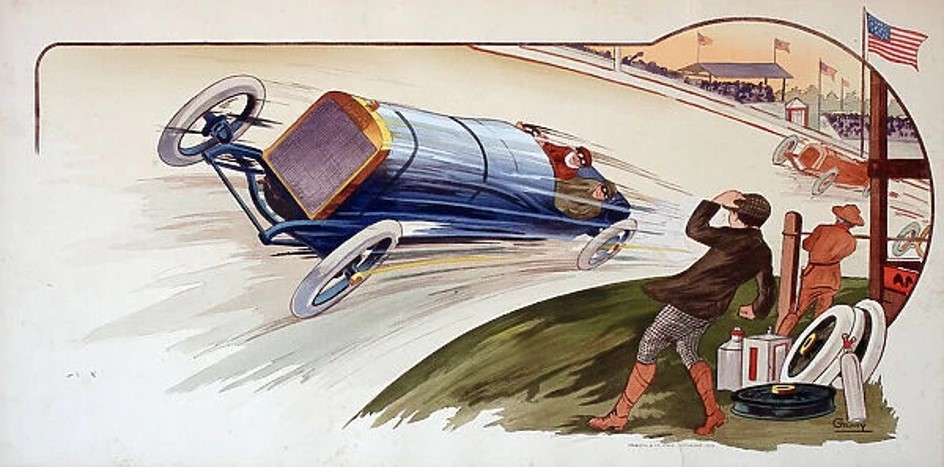On Thursday, five races were held, of which the 250-mile race for the Prest-O-Lite Trophy was supposed to be the feature-of-the-day. Just over half of the 100-laps race, William A. Bourque and his mechanic, Harry Holcomb were killed in a fiery accident. Already from the beginning, the track appeared to be unsuitable for this kind of loading.Through almost all night long into Friday, improvements were made on the track, so as to enable another two days of racing.
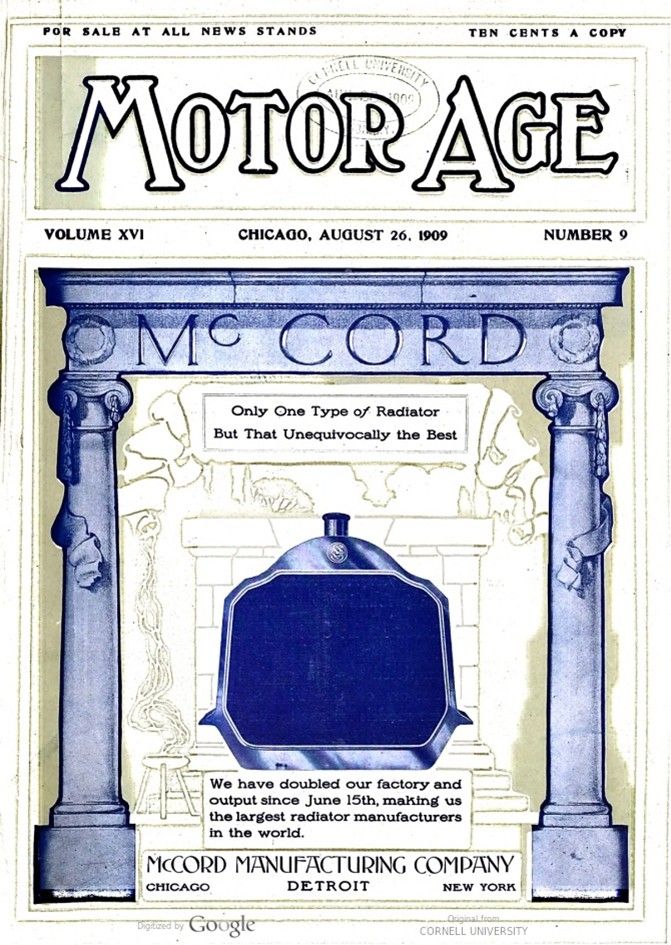

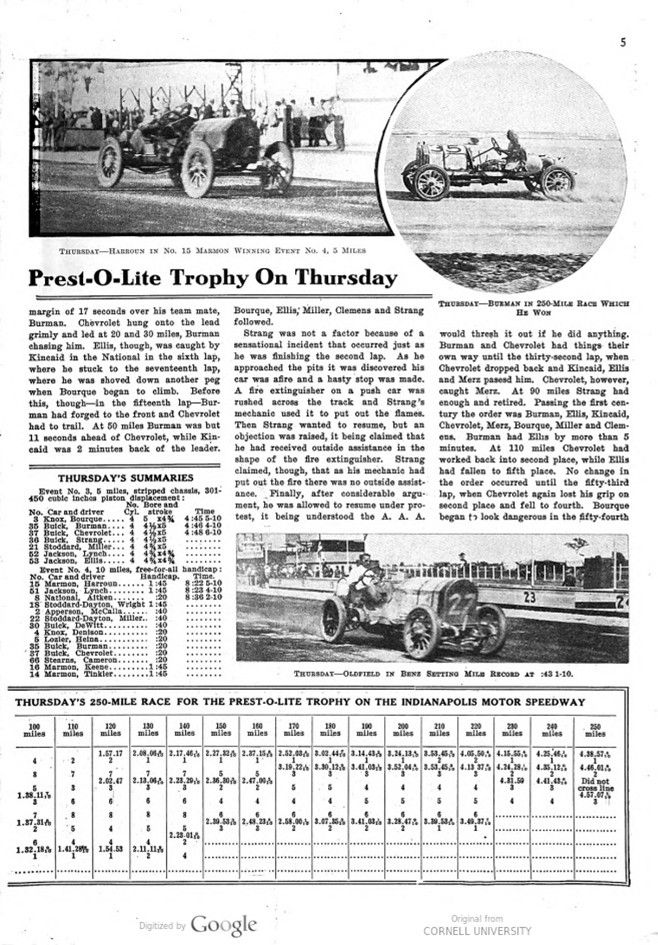
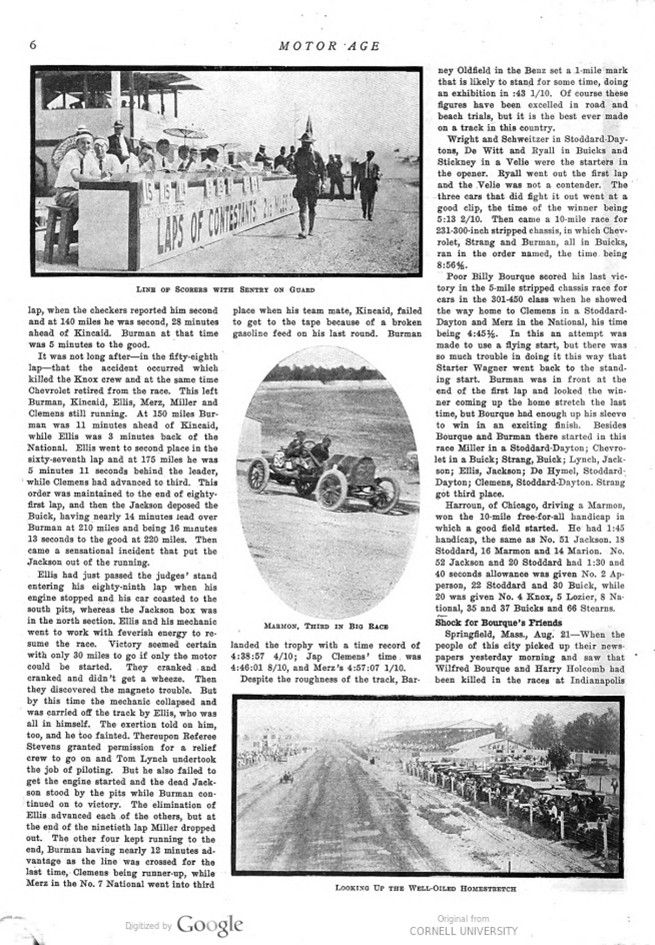

Text and jpegs by courtesy of hathitrust.org www.hathitrust.org, compiled by motorracinghistory.com
Motor Age Volume XVI, No. 9, August 26, 1909.
Burman in a Buick Wins Prest-O-Lite Trophy On Thursday
INDIANAPOLIS, Ind., Aug. 19 – A Stoddard-Dayton, driven by Schweitzer, today achieved the unique honor of capturing the first race ever run on an American speedway when it finished this afternoon in event No. 1, a 5-mile event for stripped chassis in the 161-230 cubic inches class, which opened the initial card of the Indianapolis enterprise before a crowd of 15,000 people, marking a new era in motor racing in this country.
Five races in all had been carded and each and every one of them produced fast time, although the condition of the track was none too good; in fact, the surface was so rough and the drivers complained so much about it that following the accident, which resulted in the death of Bourque and Holcombe, Referee Stevens ordered the promoters to improve the circuit before there could be another day of racing. Following this order, Director Moross prepared for a big gang of workmen laboring all night with the steam roller, and also ordered that the track be oiled at least half of its circumference because of the dust clouds raised by the flying wheels. Today only the home stretch has been treated in this manner and it was noticed that there was little dust raised at the finish. On the back stretch and turns, though, the dust was kicked up in such clouds as to make driving dangerous, as the men could not see far enough ahead to avoid cars in front.
Of course the feature of the day was the 250-mile race for the Prest-O-Lite trophy, the cars being limited to a piston displacement of from 301 to 450 cubic inches, the field including the unfortunate Bourque in the Knox, Kincaid in the National six and Merz in the National four, Strang, Chevrolet and Burman in Buicks, Miller and Clemens in Stoddard-Daytons and Ellis in the Jackson. It was the first long distance race on the speedway and naturally there was great interest displayed in it by the spectators as well as the officials. At the start Chevrolet, Burman and Ellis got out in front and at the 10-mile post it was Chevrolet who led the field with a margin of 17 seconds over his team mate, Burman. Chevrolet hung onto the lead grimly and led at 20 and 30 miles, Burman chasing him. Ellis, though, was caught by Kincaid in the National in the sixth lap, where he stuck to the seventeenth lap, where he was shoved down another peg when Bourque began to climb. Before this, though — in the fifteenth lap – Burman had forged to the front and Chevrolet had to trail. At 50 miles Burman was but 11 seconds ahead of Chevrolet, while Kincaid was 2 minutes back of the leader, Bourque, Ellis, Miller, Clemens and Strang followed.
Strang was not a factor because of a sensational incident that occurred just as he was finishing the second lap. As he approached the pits it was discovered his car was afire and a hasty stop was made. A fire extinguisher on a push car was rushed across the track and Strang’s mechanic used it to put out the flames. Then Strang wanted to resume, but an objection was raised, it being claimed that he had received outside assistance in the shape of the fire extinguisher. Strang claimed, though, that as his mechanic had put out the fire there was no outside assistance. Finally, after considerable argument, he was allowed to resume under protest, it being understood the A. A. A. would thresh it out if he did anything. Burman and Chevrolet had things their own way until the thirty-second lap, when Chevrolet dropped back and Kincaid, Ellis and Merz passed him. Chevrolet, however, caught Merz. At 90 miles Strang had enough and retired. Passing the first century the order was Burman, Ellis, Kincaid, Chevrolet, Merz, Bourque, Miller and Clemens. Burman had Ellis by more than 5 minutes. At 110 miles Chevrolet had worked back into second place, while Ellis had fallen to fifth place. No change in the order occurred until the fifty-third lap, when Chevrolet again lost his grip on second place and fell to fourth. Bourque began to look dangerous in the fifty-fourth lap, when the checkers reported him second and at 140 miles he was second, 28 minutes ahead of Kincaid. Burman at that time was 5 minutes to the good.
It was not long after—in the fifty-eighth lap—that the accident occurred which killed the Knox crew and at the same time Chevrolet retired from the race. This left Burman, Kincaid, Ellis, Merz, Miller and Clemens still running. At 150 miles Burman was 11 minutes ahead of Kincaid, while Ellis was 3 minutes back of the National. Ellis went to second place in the sixty-seventh lap and at 175 miles he was 5 minutes 11 seconds behind the leader, while Clemens had advanced to third. This order was maintained to the end of eighty-first lap, and then the Jackson deposed the Buick, having nearly 14 minutes lead over Burman at 210 miles and being 16 minutes 13 seconds to the good at 220 miles. Then came a sensational incident that put the Jackson out of the running.
Ellis had just passed the judges‘ stand entering his eighty-ninth lap when his engine stopped and his car coasted to the south pits, whereas the Jackson box was in the north section. Ellis and his mechanic went to work with feverish energy to resume the race. Victory seemed certain with only 30 miles to go if only the motor could be started. They cranked and cranked and didn’t get a wheeze. Then they discovered the magneto trouble. But by this time the mechanic collapsed and was carried off the track by Ellis, who was all in himself. The exertion told on him, too, and he too fainted. Thereupon Referee Stevens granted permission for a relief crew to go on and Tom Lynch undertook the job of piloting. But he also failed to get the engine started and the dead Jackson stood by the pits while Burman continued on to victory. The elimination of Ellis advanced each of the others, but at the end of the ninetieth lap Miller dropped out. The other four kept running to the end, Burman having nearly 12 minutes advantage as the line was crossed for the last time, Clemens being runner-up, while Merz in the No. 7 National went into third place when his team mate, Kincaid, failed to get to the tape because of a broken gasoline feed on his last round. Burman landed the trophy with a time record of 4:38:57 4/10; Jap Clemens’ time was 4:46:01 8/10, and Merz’s 4:57:07 1/10.
Despite the roughness of the track, Barney Oldfield in the Benz set a 1-mile mark that is likely to stand for some time, doing an exhibition in :43 1/10. Of course these figures have been excelled in road and beach trials, but it is the best ever made on a track in this country.
Wright and Schweitzer in Stoddard-Daytons, De Witt and Ryall in Buicks and Stickney in a Velie were the starters in the opener. Ryall went out the first lap and the Velie was not a contender. The three cars that did fight it out went at a good clip, the time of the winner being 5:13 2/10. Then came a 10-mile race for 231-300-inch stripped chassis, in which Chevrolet, Strang and Burman, all in Buicks, ran in the order named, the time being 8:56 4/5.
Poor Billy Bourque scored his last victory in the 5-mile stripped chassis race for cars in the 301-450 class when he showed the way home to Clemens in a Stoddard-Dayton and Merz in the National, his time being 4:45-1/5. In this an attempt was made to use a flying start, but there was so much trouble in doing it this way that Starter Wagner went back to the standing start. Burman was in front at the end of the first lap and looked the winner coming up the home stretch the last time, but Bourque had enough up his sleeve to win in an exciting finish. Besides Bourque and Burman there started in this race Miller in a Stoddard-Dayton; Chevrolet in a Buick; Strang, Buick; Lynch, Jackson; Ellis, Jackson; De Hymel, Stoddard-Dayton; Clemens, Stoddard-Dayton. Strang got third place.
Harroun, of Chicago, driving a Marmon, won the 10-mile free-for-all handicap in which a good field started. He had 1:45 handicap, the same as No. 51 Jackson, 18 Stoddard, 16 Marmon and 14 Marion. No. 52 Jackson and 20 Stoddard had 1:30 and 40 seconds allowance was given No. 2 Apperson, 22 Stoddard and 30 Buick, while 20 was given No. 4 Knox, 5 Lozier, 8 National, 35 and 37 Buicks and 66 Stearns.
Shock for Bourque’s Friends
Springfield, Mass., Aug. 21 – When the people of this city picked up their news. papers yesterday morning and saw that Wilfred Bourque and Harry Holcomb had been killed in the races at Indianapolis, they were shocked. Bourque was very well known in this city, because he had lived here so long. He would have been 30 years old next October and he planned to be married. He was born at West Farnham, Canada, but came to Springfield 22 years ago and secured his education here. In his earlier days he was a bicyclist. For 6 years he had been employed by the Knox company, the last 3 years as a tester, and when the company started into the racing game last fall Bourque and Denison were chosen to drive the cars. They raced in the Vanderbilt, and the Lowell races. This year Bourque competed in a number of events. He was injured at the Lowell hillclimb last June, and he also was thrown out of his car at the Springfield climb last fall, but got another and then made the best time of the day. His last appearance previous to the Indianapolis races was at Richfield Springs a week ago, where he won four trophies and was presented with the prizes by Vice-President Sherman. Chicago motorists remember him for his splendid driving in the Cobe race, when he was beaten by a few minutes only by Chevrolet. This was Holcomb’s first season in the racing game and his first race was the Indiana event, Indianapolis being his second. The bodies of the two men were brought here Saturday. That of Bourque was taken to the home of his parents here and Holcomb’s was sent to West Granville, where his family lived. Funeral services will be held for both to- morrow, and it is probable the Knox plant will be closed out of respect to the memory of the dead racing men.
William E. Wright, general manager of the Knox company, has not decided what will be done relative to future racing. He feels the deaths keenly, for there is a spirit of fraternity in the Knox factory whereby the men look up to Mr. Wright as they would to a father, and he does not feel like sacrificing any lives of his “boys“ as he calls them, no matter what the inducements are. Just what caused the accident is an enigma here. Bourque was noted for his quickness, especially with the emergency lever, which he used almost entirely in racing. He had the notches taken off the brake so it would release instantly. The fact of the matter, as believed by his friends here, is that he was taken ill from the strain of racing. While he was tall and wiry, he did not look very well this summer and his friends believe that the physical strain caused him to collapse and that brought on the finish at Indianapolis.
If the Knox company continues racing there is some talk of sending for Fred Belcher, who won a race in Texas last week in a Knox. The company has its quarters all engaged in Lowell and last week Bourque went there and drove over the course, saying he expected to get one of the prizes at least. Much will depend upon the decision of Denison, Bourque’s partner. His relatives may object to his continuing as a driver, and in that case the company may withdraw its entries at Lowell and elsewhere, where the Knox has been scheduled to compete during the fall months.
Favor Change of Rules
Indianapolis, Ind., Aug. 23 – Officials of the Indianapolis motor speedway are planning for a radical change in rules for long distance events. While the management will not meet until later in the week to discuss the proposed changes, those interested in the speedway have given individual expressions favoring changes in the rules. It is believed that when the new rules are drafted, the A. A. A. will not hesitate to sanction long events. Carl G. Fisher, president of the speedway company, said today it was certain events longer than 100 miles would not run in the future on the track unless the rules were changed. He said that it was probable the new rules would provide that for long events the drivers and tires should be changed each 100 miles and that drivers would be subjected to a severe physical examination. It is also the intention to change the arrangement of stands and fences. The railing will be moved back several feet and the private boxes, now on the first curve of the track, will be moved either opposite the grand stand on the inside of the course, or placed north of the grand stand on that side of the track. The factory of the National Motor Vehicle Co. was closed today out of respect for Claude Kellum, the National mechanician, who was killed Saturday afternoon in the 300-mile race.

